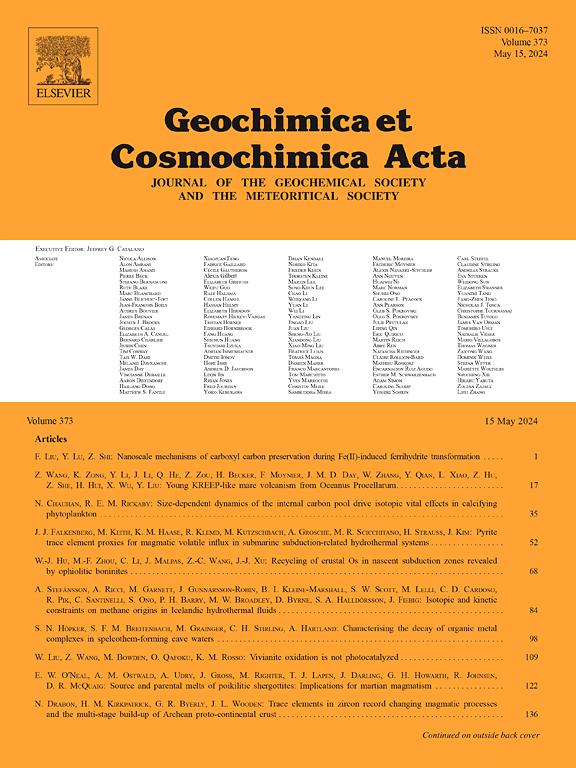Stable Mo isotopic fractionation during complexation onto hematite surface: Molecular insights from Ab-initio MD and X-ray absorption spectroscopy
IF 5
1区 地球科学
Q1 GEOCHEMISTRY & GEOPHYSICS
引用次数: 0
Abstract
Iron (hydr)oxides are key sorbents of molybdenum (Mo) in a wide range of environmental settings. Among them, hematite (α-Fe2O3) is the most stable iron oxide under surficial conditions; however, the extent and molecular-scale mechanisms of Mo isotopic fractionation on hematite across variable pH conditions have remained poorly constrained. In this study, we conducted a series of Mo adsorption experiments at pH 5.0–9.0 to investigate isotopic fractionation and identified two distinct fractionation regimes under acidic and alkaline conditions. Mo isotopic fractionation remained relatively constant between pH 4.0 and 7.0, with Δ98Mo[Mo(aq)-Mo(hematite)] ≈ 2.10‰, indicating minimal pH sensitivity. Above pH 7, however, fractionation decreased markedly, with values declining to 1.80‰ at pH 8 and 1.37‰ at pH 9.
Ab initio molecular dynamics (AIMD) simulations indicate that Mo is predominantly present as a five-fold coordinated complex at the water–hematite interface. This structural motif is supported by Mo K-edge X-ray absorption near-edge structure (XANES) spectra, which show that the local coordination environment of sorbed Mo differs from that of MoO3 (octahedral geometry) and cannot be explained by a simple mixture of tetrahedral and octahedral species. Extended X-ray absorption fine structure (EXAFS) analysis yields an average Mo–O coordination number of 4.3 ± 0.9 at pH = 5.0 and 4.7 ± 0.9 at pH = 7.0, consistent with prior observations (5.3 ± 0.6), thereby corroborating the predominance of a five-fold Mo species.
Theoretical isotopic fractionation for this five-fold complex, calculated as Δ98Mo[Mo(aq)-Mo(five-fold complex)] = 2.01 ‰ at 20 °C, agrees well with our experimental results (Δ98Mo[Mo(aq)-Mo(hematite)] = 1.899 ± 0.322 ‰) and previous data (2.19 ± 0.54 ‰). A two-component model incorporating both five-fold and tetrahedral Mo complexes successfully reproduces the observed pH-dependent fractionation trend. Collectively, these findings demonstrate that Mo isotope fractionation on hematite is strongly pH-dependent and governed by changes in surface complexation geometry, with implications for the application of Mo isotopes as tracers in both natural and anthropogenically influenced systems, from continental weathering profiles to aqueous transport pathways.
赤铁矿表面络合过程中稳定的Mo同位素分馏:来自Ab-initio MD和x射线吸收光谱的分子见解
铁(氢)氧化物是钼(Mo)在广泛的环境设置的关键吸附剂。其中,赤铁矿(α-Fe2O3)是表面条件下最稳定的氧化铁;然而,在不同的pH条件下,Mo同位素在赤铁矿上分馏的程度和分子尺度机制仍然没有得到很好的约束。在本研究中,我们在pH 5.0-9.0条件下进行了一系列Mo吸附实验,研究了同位素分馏过程,并在酸性和碱性条件下确定了两种不同的分馏机制。Mo同位素分馏在pH 4.0 ~ 7.0之间保持相对稳定,Δ98Mo[Mo(aq)-Mo(赤铁矿)]≈2.10‰,pH敏感性极小。pH高于7时,分馏值明显下降,pH为8时为1.80‰,pH为9时为1.37‰。从头算分子动力学(AIMD)模拟表明,Mo主要以五重配位配合物的形式存在于水-赤铁矿界面。该结构基序得到了Mo k -边缘x射线吸收近边缘结构(XANES)光谱的支持,表明Mo吸附的局部配位环境不同于MoO3(八面体几何),不能简单地用四面体和八面体物质的混合来解释。扩展x射线吸收精细结构(EXAFS)分析结果显示,pH = 5.0时Mo - o配位数平均为4.3±0.9,pH = 7.0时为4.7±0.9,与之前的观察结果(5.3±0.6)一致,从而证实了五重Mo的优势。该五重配合物在20℃时的理论同位素分馏值为Δ98Mo[Mo(aq)-Mo(五重配合物)]= 2.01‰,与我们的实验结果(Δ98Mo[Mo(aq)-Mo(赤铁矿)]= 1.899±0.322‰)和之前的数据(2.19±0.54‰)吻合良好。一个包含五重和四面体Mo配合物的双组分模型成功地再现了所观察到的ph依赖的分馏趋势。总的来说,这些发现表明,Mo同位素在赤铁矿上的分馏具有很强的ph依赖性,并受表面络合几何形状变化的控制,这意味着Mo同位素作为示踪剂在自然和人为影响系统中的应用,从大陆风化剖面到水输送途径。
本文章由计算机程序翻译,如有差异,请以英文原文为准。
求助全文
约1分钟内获得全文
求助全文
来源期刊

Geochimica et Cosmochimica Acta
地学-地球化学与地球物理
CiteScore
9.60
自引率
14.00%
发文量
437
审稿时长
6 months
期刊介绍:
Geochimica et Cosmochimica Acta publishes research papers in a wide range of subjects in terrestrial geochemistry, meteoritics, and planetary geochemistry. The scope of the journal includes:
1). Physical chemistry of gases, aqueous solutions, glasses, and crystalline solids
2). Igneous and metamorphic petrology
3). Chemical processes in the atmosphere, hydrosphere, biosphere, and lithosphere of the Earth
4). Organic geochemistry
5). Isotope geochemistry
6). Meteoritics and meteorite impacts
7). Lunar science; and
8). Planetary geochemistry.
 求助内容:
求助内容: 应助结果提醒方式:
应助结果提醒方式:


